T violation
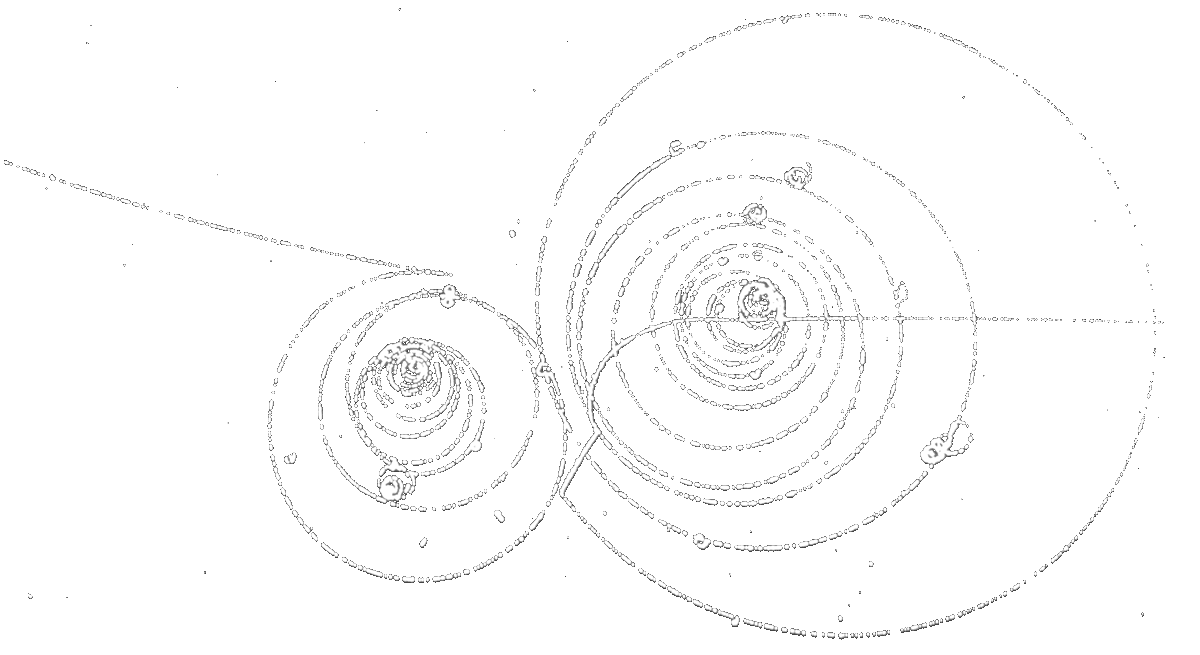
1. The 'Representation View'
- Thesis 1. Time has structural features characterised locally by a representation.
- Thesis 2. An arrow of time emerge from that relational structure.
Thesis 1
Time, whatever it is, has rich structural features
\(t\) = two o'clock
\(t\) = time-translate by two hours
The 'Representation View'
The representation of spacetime structure contains a great deal of physics.
Some Motivation:
- Relationism: Earman (1989) World Enough and Spacetime
- Spacetime Functionalism: Knox (2013, 2019), Butterfield and Gomes (2020)
- Wigner-Bargmann Picture: Wigner (1939), Bargmann (1954)
Example. When do we have a time translation as opposed to a spatial transation?
- Sociology: When we use the letter \(t\).
- Physics: When we have a representation of time translations.
Representing Spacetime
Spacetime Structure
\(g\in G\)
\(\overset{\mbox{\(\phi\)}}{\longrightarrow}\)
State Space Symmetries
\(U_g:\mathcal{H}\rightarrow\mathcal{H}\)
Representing Spacetime
- Wigner (1939) on the Poincaré group
- "The Representation View" (BWR, Forthcoming)
Example
Time translations represented among State space symmetries
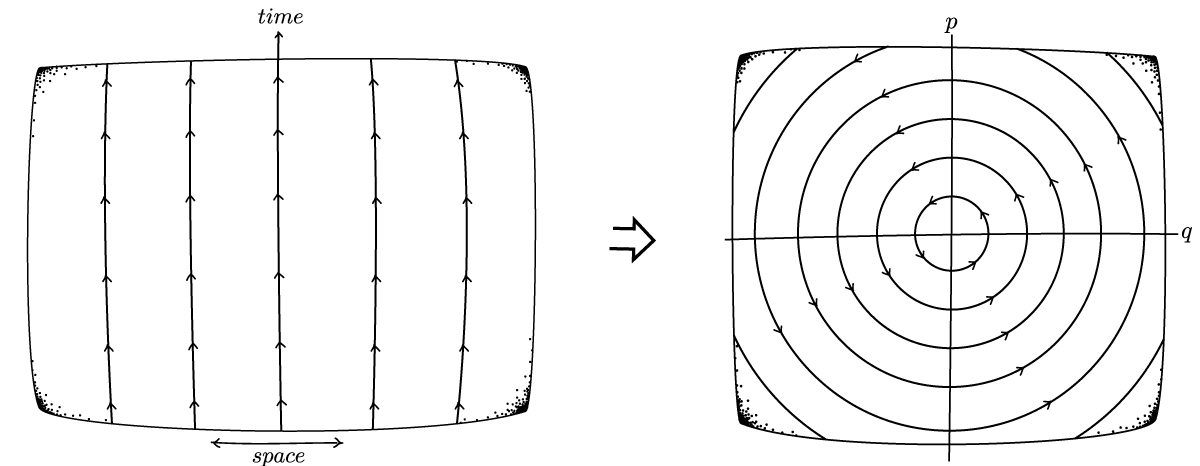
Example
- Classical Mechanics:
Time translations: \(G=(\mathbb{R},+)\)
State symmetries: (anti)symplectics \(\phi : \phi^*\omega=|\omega|\)
Representing Time: Homomorphism \(t \mapsto \phi_t\).
- \(X = \tfrac{d}{dt}\phi_t \;\Rightarrow\;\) \(\iota_X\omega = dh\) \( \;\Rightarrow\; \dot{q}=\partial h/\partial p, \dot{p} = -\partial h/\partial q \)
(in each local neighbourhood)
Example
- Quantum Mechanics:
Time translations: \(G=(\mathbb{R},+)\)
State symmetries: (anti)unitaries \(U : U^*U=UU^*\)
Representing Time: Homomorphism \(t \mapsto U_t\).
- \(\psi(t) := U_t\psi \;\Rightarrow\;\) \(i\tfrac{d}{dt}\psi(t) = H\psi(t)\) with \(U_t=e^{-itH}\)
Examples
- Poincaré group \(P^\uparrow_+ \;
\overset{\mbox{\(\phi\)}}{\longrightarrow}\; \phi(P^\uparrow_+)\) Unitary Hilbert space Rep
(Wigner 1939) - A discrete group for discrete time, etc.
Confusion can arise if we ignore the two part nature of time.
Electromagnetism is not invariant under \(E(t),B(t) \mapsto E(-t),B(-t)\)
...but rather under \(E(t),B(t)\mapsto E(-t),-B(-t)\).
Also in quantum mechanics:
The Schrödinger equation is not invariant under \(\psi(t)\mapsto\psi(-t)\)
- But it is under "Wignerian" time reversal
- \(\psi(t)\mapsto \psi^*(t)\;\;\) (Schrödinger position rep)
- \(\psi(t)\mapsto \sigma_y \psi^*(t)\;\;\) (Pauli rep)
Q: Isn't 'true' time reversal just
\(t\mapsto-t\)?
Some authors adopt this...
...and forget this...
...and this.
Time Translations
\(t\in G\)
\(\overset{\mbox{\(\phi\)}}{\longrightarrow}\)
State Symmetries
\(U_t:\mathcal{H}\rightarrow\mathcal{H}\)
A group \(S\) of automorphisms of \(G\) defines via the semidirect product an extension of the group to \(G\ltimes S\).
- \((\mathbb{R},+)\) extends to time translations w/time reversal \(\tilde{G} = (\mathbb{R},+)\ltimes\{I,\tau\}\)
- \(P^\uparrow_+\) extends to the `full' Poincaré group \(P = P^\uparrow_+\ltimes\{I,\tau,\pi,\pi\tau\}\)
Many references, e.g. Varadarajan (2007)
In these extensions, \(\tau\) implements time reversal by conjugation:
\(\tau t \tau^{-1} = -t\)This is the definition of time reversal on the time side.
But we have two sides:
Time Translations
\(\tau t \tau^{-1} = -t\)
\(\overset{\mbox{\(\phi\)}}{\longrightarrow}\)
State Symmetries
\(TU_t T^{-1} = U_{-t}\)
The problem of defining time reversal on a state space is just the problem of extending a representation of time translations \(G\) to a representation of \(\tilde{G}\) including time reversal \(\tau\in \tilde{G}\).
Given a representation of time translations \(G\), a representation of time reversal may not exist. This occurs precisely when there is time-reversal symmetry violation.
Thesis 2
An arrow of time emerges from time's relational structure.
T-violation on state space holds information about the asymmetries of time

...just as a shadow holds information about the asymmetries of the object.
When an extension of time translations to include time reversal does exist, \(\tau:t\mapsto-t\) is generally represented by a non-trivial state-space operator.
Temporal 'arrows'
- Thermal asymmetry
- Born rule asymmetry
- Weak asymmetry
- Time of arrival asymmetry
- Clock asymmetry
- Entanglement asymmetry
- Shrinking \(W^*\)-Algebra asymmetry
- Cosmological asymmetry
- Aging asymmetry
- Lady Macbeth asymmetry
- London real estate asymmetry
- Free will/Choice asymmetry
- Boring/Creative time asymmetry
- Moving now asymmetry
- Knowledge asymmetry
- Causal Markov asymmetry
Strategy for detecting time's arrow:

Given a dynamical asymmetry, one can infer a spacetime asymmetry.
T Violation
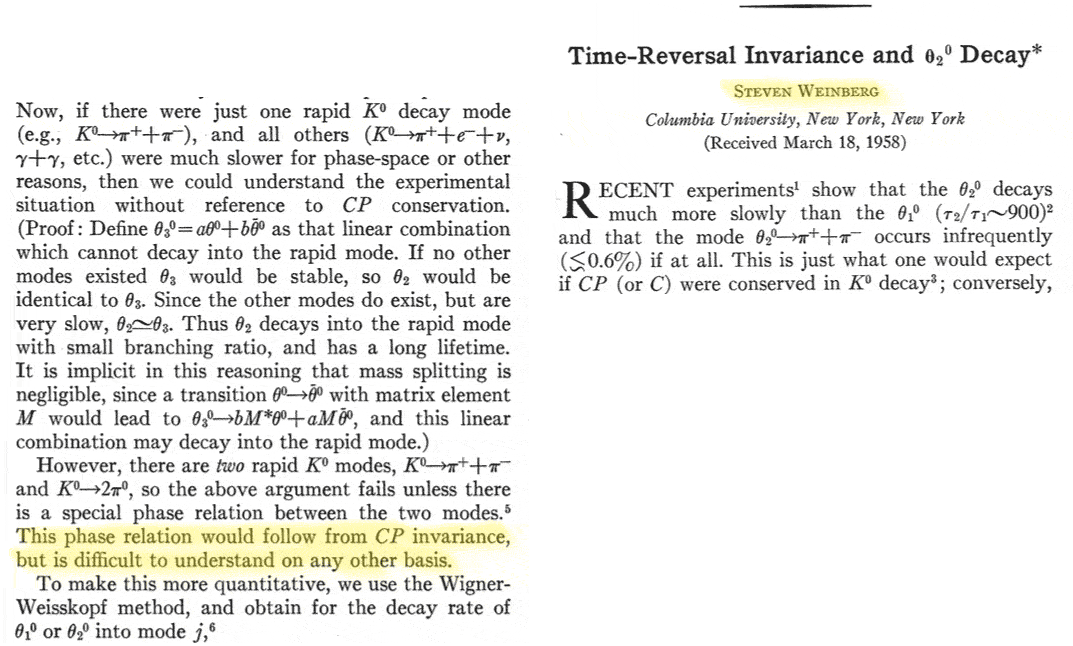
Weinberg (1958) Phys. Rev. Lett.
It just seemed evident that CP symmetry should hold. People are very thick-skulled. We all are. Even though parity had been overthrown a few years before, one was quite confident about CP symmetry.
— James Cronin (1982) Physics Today
"It came as a great shock that microscopic T-invariance is violated in nature, that 'nature makes a difference between past and future' even on the most fundamental level."
Bigi and Sanda (2009) CP Violation
A great, but fleeting shock: We tend to immediately ignore it.
"Just as we postulate that the law of motion of a given system is invariant under certain spatial transformations, we can also postulate that it is reversible with respect to time."
Messiah, QM
"The best strategy is to set the case of the kaon to one side"
Huw Price, Time's Arrow & Archimedes' Point
"Since there are so many individually dubious assumptions in this argument [for T-violation], we may regard their conjuction as quite implausible." (p.56)
— Horwich (1987) Asymmetries in Time
But there are benefits to not ignoring T violation:
- Robust evidence for an arrow of time
- Explanatory use: Baryon asymmetry
"When certain effects show a certain asymmetry, this asymmetry must be found in the causes which gave rise to them" (and vice versa (1894, 1886)
Symmetry of the cause: symmetry of dynamical evolution + symmetry of the initial state
↓
Symmetry of the effect: symmetry of the final state
If a law is invariant under a symmetry,
then the initial and final states both share or both fail to share that symmetry.
equivalent contrapositive:
If the initial and final states do not share the same symmetries,
then they are not symmetries of the laws.
Proposition 1. (Curie) Suppose the initial and final states \(\psi\) and \(U\psi\) do not share a unitary symmetry \(A\), in that either,
- (in but not out) \(A\psi=\psi\) but \(AU\psi \neq U\psi\), or
- (out but not in) \(AU\psi = U\psi\) but \(A\psi \neq\psi\),
then we have A-symmetry violation, \( AUA^*\neq U \).
More empirically helpful: a scattering version.
Proposition 2. (Scattering Curie) If a unitary symmetry \(A\) and a non-zero decay amplitude \(\langle\psi^{in},S\psi^{out}\rangle\) for a scattering matrix \(S\) satisfy either,
- (in but not out) \( A\psi^{in} = \psi^{in} \) but \( A\psi^{out} = -\psi^{out} \), or
- (out but not in) \( A\psi^{out} = \psi^{out} \) but \( A\psi^{in} = -\psi^{in} \),
then we have A-symmetry violation, \( ASA^*\neq S \).
Example: CP-violating decay mode
\(K_L\) and \(\pi^+\pi^-\) do not share the same CP symmetry:
\(CP(\pi^+\pi^-) = \pi^+\pi^- \;\;\) but \(\;\; CP(K_L) = -K_L\)
Therefore, \(K_L \rightarrow \pi^+\pi^-\) is a CP-violating decay mode.
Does it occur?
Indirect T-violation
Given CPT invariance, CP-violation is equivalent to T-violation.
Remark 1: The Curie technique is much more general than orthodox QFT
Proposition 2'. Let \(C\) and \(E\) be any two sets. Let \(\sigma:C\rightarrow C\) and \(\sigma:E\rightarrow E\) be bijections (the "symmetries"), and let \(S:C\rightarrow E\) be a bijection (the "dynamics"). If either
- (in but not out) \( \sigma x = x\) but \(\sigma Sx \neq Sx\), or
- (out but not in) \( \sigma Sx = Sx\) but \( \sigma x \neq x \),
then we have \(\sigma\)-symmetry violation, \( S\sigma \neq \sigma S \).
A. Ashtekar (2015) "Response..."
So, this detection of symmetry violation is extremely general.
Remark 2: The Curie principle, that a symmetry of an initial state and a law is also a symmetry of the final state, does not apply to time reversal.
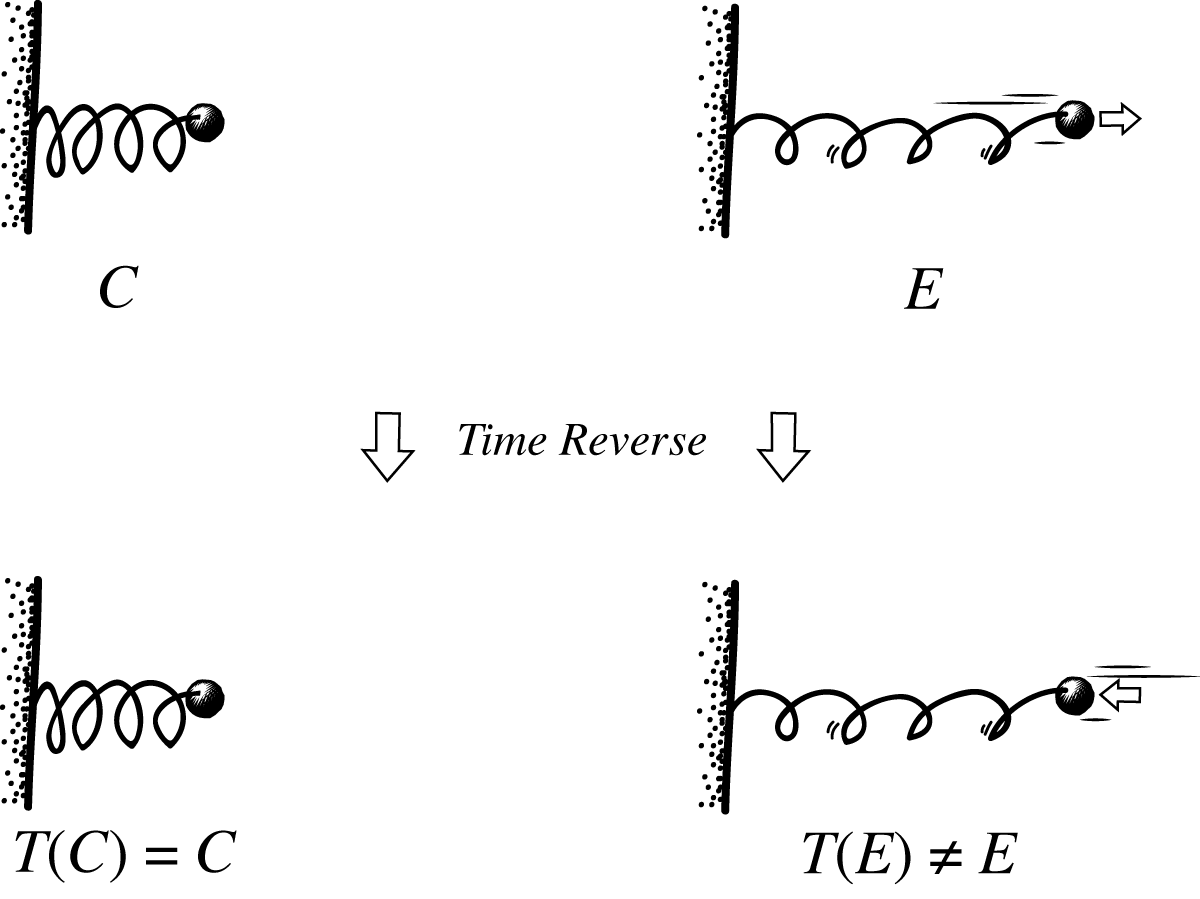
Result: a direct test of T-violation requires a completely new kind of strategy, first tested in 1998.
Roberts (2013) "The simple failure..."
Kabir's principle (Kabir 1968, 1970)
Kabir Principle: If a decay occurs with different frequency than its time-reverse, then we have T-violation.
Proposition 3. Let \(\psi^{in}\rightarrow\psi^{out}\) be a decay mode with time-reverse \(T\psi^{out}\rightarrow T\psi^{in}\). If the amplitudes of these decay modes differ, i.e.,
\[ \langle\psi^{out},S\psi^{in}\rangle \neq \langle T\psi^{in},ST\psi^{out}\rangle, \]then we have T-violation, \(TST^{-1} \neq S^*\).
Kabir strategy at the LHC:
\[K^0 \leftrightarrows \bar{K}^0 \]
Neutral kaon oscillation
Kaon to Antikaon amplitude: \( \langle \bar{K}^0, SK^0\rangle \)
Time-reversed Antikaon to Kaon amplitude: \( \langle K^0, S\bar{K}^0\rangle \)

Kabir's Principle: If these amplitudes differ, then the interaction is T-violating.
CPLEAR 1998: Angelopolous et al. measure these amplitudes and confirm they differ,
\[ \langle \bar{K}^0, SK^0\rangle \neq \langle K^0, S\bar{K}^0\rangle.\]which implies the evolution is T-violating.
The confirmation is also "direct" in that it does not presume CPT-invariance.
Remark 1: Similar processes are actively being investigated in other sectors.
- B-meson oscillation: T-violation at SLAC in 2012.
- Neutrino-oscillation: Candidate for future T-violation.
Remark 2: The Kabir principle is much more general than QFT. In this sense the evidence is "here to stay".
"Here to stay": T-violation holds even without...
- Linearity
- Transition probabilities
- Unitary dynamics
- Lorentz symmetry
Caveat: Some assumptions about ingoing/outgoing states still needed.
- Kabir Generalization: Replace the concept of "amplitude" with a more general "overlap map". Then it can be shown to hold even classically.
Roberts (2015), arXiv:1306.6382
Ashtekar (2015), arXiv:1307.1331
Fact 2': For any set \(S\), if \(M\) is an overlap map \(M:S\times S\rightarrow[0,1]\) compatible with a bijection \(T:S_i\rightarrow S_f\), then
\[M(\sigma,S\rho) \neq M(T\rho,ST\sigma)\]implies T-violation, \(TS \neq S^*T\).
Ashtekar (2015), arXiv:1307.1331
Summary: Symmetry principles for T-violation
 1. CPT + Curie's principle:
1. CPT + Curie's principle:
Compare decay products
Requires CPT/Lorentz symmetry
 2. Kabir's principle:
2. Kabir's principle:
Compare transition amplitudes
General and direct evidence
"the main strength of the more general perspective presented here is that it broadens the reach of the Cronin-Fitch and CPLEAR experiments enormously."
Further Remarks
On ignoring T-violation:
"Since there are so many individually dubious assumptions in this argument [for T-violation], we may regard their conjuction as quite implausible." (p.56)
— Horwich (1987) Asymmetries in Time
...And that's good.
Because a little T-violation helps us identify an arrow of time itself.
Weak T-violation is a pervasive but small effect, occurring in 1 out of every 500 decays.
Remark: this does not mean it is not important
Application: Explaining baryon asymmetry.
A small early-universe baryon asymmetry could amplify to become the large baryon asymmetry we see today.
Sakharov (1967) Conditions
Appeal to symmetry violation:
- Baryon-number violation
- C-violation and CP/T-violation
- Appropriate thermodynamic conditions
...to explain the observed baryon-asymmetry.
These are necessary but not sufficient conditions.
But it would be silly to ignore this explanation of the structure of our universe because we were busy ignoring T-violation.
Summary
- On the representation view T violation is evidence for an arrow of time.
- The general templates for T-violation are here to stay.
- T-violation may help us explain baryon asymmetry.
Wigner on Kramers Degeneracy: Let \(H\) be a time-reversal invariant Hamiltonian for an odd number of fermions and let \(T\) be the time reversal operator, i.e.,
- Time reversal invariance: \([H,T] = 0 \)
- Fermion condition: \(T^2 = -I,\)
then \(H\) has a degenerate spectrum.
i.e. \(H\) admits a pair of orthogonal eigenvectors with the same eigenvalue.
Contrapositive: If \(H\) describes an odd-number of fermions but is not doubly degenerate, then it is T-violating.
Example: The neutron

...if it has an elementary electric dipole moment.
Candidate Hamiltonian: \(H = \tfrac{1}{2m}P^2 + S\cdot E\)
\(S\) is angular momentum and \(E\) is the electric field.
\(H\) is non-degenerate, and it is therefore T-violating by Wigner's principle. (And this always holds for such dipole moments.)